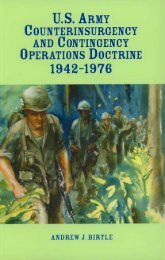C. Wiebes - Intelligence en de oorlog in Bosnië 1992-1995. De rol van de inlichtingen- en veiligheidsdiensten - Engels
C. Wiebes - Intelligence en de oorlog in Bosnië 1992-1995. De rol van de inlichtingen- en veiligheidsdiensten - Engels
C. Wiebes - Intelligence en de oorlog in Bosnië 1992-1995. De rol van de inlichtingen- en veiligheidsdiensten - Engels
- No tags were found...
You also want an ePaper? Increase the reach of your titles
YUMPU automatically turns print PDFs into web optimized ePapers that Google loves.
195In addition Com<strong>in</strong>t can be important ev<strong>en</strong> if the co<strong>de</strong> is not brok<strong>en</strong>, because an analysis of thetraffic <strong>in</strong> comb<strong>in</strong>ation with El<strong>in</strong>t can <strong>en</strong>able <strong>in</strong>tellig<strong>en</strong>ce services to establish the location, movem<strong>en</strong>tsand ev<strong>en</strong> the str<strong>en</strong>gth of the Armed Forces. 1036 Increas<strong>in</strong>g transmission activity from a militaryheadquarters can, for <strong>in</strong>stance, be an <strong>in</strong>dication of an imm<strong>in</strong><strong>en</strong>t military operation. Before this chaptermoves on to a closer exam<strong>in</strong>ation of the claims ma<strong>de</strong> <strong>in</strong> publications regard<strong>in</strong>g <strong>in</strong>terceptedcommunications traffic and the possible successes and failures <strong>in</strong> this Sig<strong>in</strong>t war betwe<strong>en</strong> the warr<strong>in</strong>gparties, Section 2 will first outl<strong>in</strong>e the ad<strong>van</strong>tages and disad<strong>van</strong>tages of Sig<strong>in</strong>t. This is important becausethese are also reflected <strong>in</strong> the war <strong>in</strong> Bosnia dur<strong>in</strong>g the period <strong>1992</strong> to <strong>1995.</strong>Subsequ<strong>en</strong>tly, section 3 <strong>de</strong>votes brief att<strong>en</strong>tion to the history of the most important Sig<strong>in</strong>tServices that focused on the war <strong>in</strong> Bosnia. A <strong>de</strong>scription is giv<strong>en</strong> of the largest (<strong>in</strong> budget and staff)service <strong>in</strong> the world, the American National Security Ag<strong>en</strong>cy (NSA). Att<strong>en</strong>tion is also <strong>de</strong>voted toseveral other western bodies, such as the Canadian Communications Security Establishm<strong>en</strong>t (CSE), theBritish Governm<strong>en</strong>t Communications Headquarters (GCHQ), the German Bun<strong>de</strong>snachricht<strong>en</strong>di<strong>en</strong>st(BND) and the Fr<strong>en</strong>ch Direction du R<strong>en</strong>seignem<strong>en</strong>t Militaire (DRM). This section also <strong>de</strong>scribes theresources that these services employed <strong>in</strong> Bosnia.Section 4 th<strong>en</strong> turns to the difficult issue of exchang<strong>in</strong>g Com<strong>in</strong>t (especially of a strategic nature)betwe<strong>en</strong> fri<strong>en</strong>dly Western Services. The results of Com<strong>in</strong>t are g<strong>en</strong>erally subject to strict secrecy and ar<strong>en</strong>ot automatically shared by Western services with sister services. Ev<strong>en</strong> with<strong>in</strong> NATO Sig<strong>in</strong>t is notexchanged with full freedom; this is partly because the <strong>Intellig<strong>en</strong>ce</strong>-gather<strong>in</strong>g Service does not wish toreveal its own capacities. A variety of accounts have be<strong>en</strong> published regard<strong>in</strong>g the results achieved <strong>in</strong>the field of Com<strong>in</strong>t.In Section 5 these are compared and supplem<strong>en</strong>ted by the author’s own research. On the basisof the goals of Com<strong>in</strong>t and El<strong>in</strong>t a dist<strong>in</strong>ction is ma<strong>de</strong> betwe<strong>en</strong> the follow<strong>in</strong>g categories: firstly thediplomatic and military communications traffic of the warr<strong>in</strong>g factions (the military targets), such as theVJ <strong>in</strong> Serbia; secondly the VRS <strong>in</strong> the Republika Srpska and the ABiH <strong>in</strong> Bosnia; thirdly the El<strong>in</strong>ttargets <strong>in</strong> and around Bosnia; and f<strong>in</strong>ally UNPROFOR as a target. What can be said about thesuccesses and the reliability of the published accounts? This section also consi<strong>de</strong>rs the capacities andactivities of the Af<strong>de</strong>l<strong>in</strong>g Verb<strong>in</strong>d<strong>in</strong>gs<strong>in</strong>licht<strong>in</strong>g<strong>en</strong> (Sig<strong>in</strong>t <strong>De</strong>partm<strong>en</strong>t) of the Netherlands Military<strong>Intellig<strong>en</strong>ce</strong> Service (MIS). F<strong>in</strong>ally, the conclusion <strong>in</strong> Section 6 looks back at the Sig<strong>in</strong>t war betwe<strong>en</strong><strong>1992</strong> and 1995 and exam<strong>in</strong>es the <strong>rol</strong>e and the importance of Com<strong>in</strong>t dur<strong>in</strong>g the war <strong>in</strong> Bosnia.2. The ad<strong>van</strong>tages and disad<strong>van</strong>tages of Signals <strong>Intellig<strong>en</strong>ce</strong>Little is known about Sig<strong>in</strong>t dur<strong>in</strong>g the Cold War and follow<strong>in</strong>g the fall of the Berl<strong>in</strong> Wall. 1037 A blanketof secrecy has always la<strong>in</strong> over this subject. Sig<strong>in</strong>t is rather technical <strong>in</strong> nature and it is thus oft<strong>en</strong>difficult to expla<strong>in</strong> its importance. This is one reason why sci<strong>en</strong>tists and journalists have g<strong>en</strong>erallyavoi<strong>de</strong>d the subject. The little att<strong>en</strong>tion that has be<strong>en</strong> <strong>de</strong>voted to Sig<strong>in</strong>t <strong>in</strong> pr<strong>in</strong>t mostly relates to WorldWar II. 1038 Nonetheless, thanks to the specific <strong>in</strong>formation that it provi<strong>de</strong>d Sig<strong>in</strong>t has be<strong>en</strong> of <strong>en</strong>ormousimportance <strong>in</strong> military conflicts dur<strong>in</strong>g and after the Cold War. S<strong>in</strong>ce time immemorial, governm<strong>en</strong>tshave always wanted to know what their <strong>en</strong>emies (but also their fri<strong>en</strong>ds) are up to. The easiest way tof<strong>in</strong>d this out is simply to list<strong>en</strong> to their communications traffic. By way of illustration, the former headof the US Navy Com<strong>in</strong>t organization wrote: ‘The ambition of every nation has be<strong>en</strong> to <strong>de</strong>velopunbreakable ciphers for its own use and to solve every cipher <strong>in</strong> use by its actual or pot<strong>en</strong>tial<strong>en</strong>emies.’ 10391036 Polmar & All<strong>en</strong>, Spybook, 1998, p. 131 and Richelson, The US <strong>Intellig<strong>en</strong>ce</strong> Community, pp. 24-27.1037 This section makes ext<strong>en</strong>sive use of: Matthew Aid & Cees <strong>Wiebes</strong>, ‘Introduction on the importance of SIGINT <strong>in</strong> theCold War’, Aid & <strong>Wiebes</strong> (eds.), Secrets, pp. 1-24.1038 For a <strong>de</strong>tailed discussion of this see: Matthew M. Aid, ‘Not So Anonymous: Part<strong>in</strong>g the Veil of Secrecy About the NSA’,<strong>in</strong>: Theoharis (ed.), Culture, pp. 65-67.1039 NA, RG-457, CP, SRH-264, A Lecture on Communications <strong>Intellig<strong>en</strong>ce</strong> by Capta<strong>in</strong> J.N. W<strong>en</strong>ger, USN, 14/08/46, p. 8.





